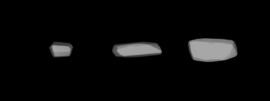Discovered by S. Belyavsky MPC designation 2156 Kate Discovered 23 September 1917 Orbits Sun | Discovery date 23 September 1917 Minor planet category main-belt · (inner) Aphelion 2.69 m Asteroid group Asteroid belt | |
 | ||
Named after Kate Kristensen(wife of naming astronomer) Alternative names A917 SH · 1937 PK1954 UT2 · 1956 GP1957 QK · 1969 BE1970 LK · 1974 RL11976 GK1 · 1979 BC Similar Sun, 852 Wladilena, 849 Ara, 1001 Gaussia, 812 Adele | ||
2156 Kate, provisional designation A917 SH, is a stony asteroid from the inner regions of the asteroid belt, approximately 8 kilometers in diameter. It was discovered on 23 September 1917, by Soviet–Russian astronomer Sergey Belyavsky at Simeiz Observatory on the Crimean peninsula.
The S-type asteroid is also classified as a rather rare and uncommon A-type by Pan-STARRS' large-scale survey. It orbits the Sun at a distance of 1.8–2.7 AU once every 3 years and 4 months (1,227 days). Its orbit has an eccentricity of 0.20 and an inclination of 5° with respect to the ecliptic. As no precoveries were taken, the asteroid's observation arc begins with its discovery in 1917.
A large number of rotational light-curves were obtained from photometric observations. They gave a well-defined rotation period of 5.620 to 5.623 hours with a brightness variation between 0.5 and 0.9 in magnitude (U=3/3-).
According to the survey carried out by the NEOWISE mission of NASA's space-based Wide-field Infrared Survey Explorer, the asteroid measures 8.1 kilometers in diameter and its surface has an albedo of 0.19 and 0.22, respectively, while the Collaborative Asteroid Lightcurve Link assumes a standard albedo for stony asteroids of 0.20 and calculates a diameter of 8.6 kilometers.
The minor planet was named after Kate Kristensen, wife of astronomer L. K. Kristensen, who was involved in the body's orbit computation. Naming citation was published on 1 April 1980 (M.P.C. 5284).
